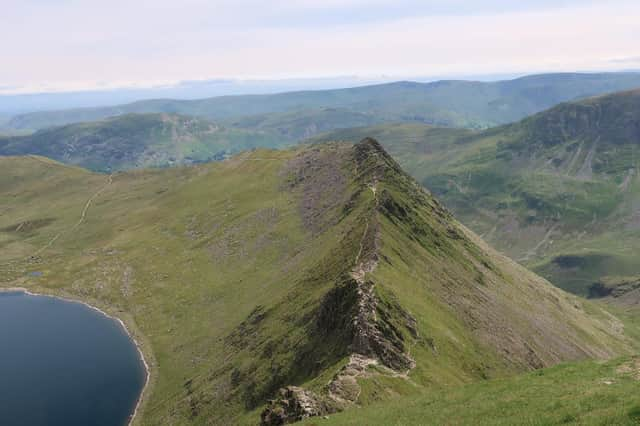A grim tale about one very faithful dog | Steve Canavan


I mention this not because I’ve been there this week, but because a friend sent me some pictures of a walk we did on that very peak two years ago, and one of the photos was of the memorial stone.
I thought it worth mentioning because it is a rather lovely, stirring tale. Not, admittedly, for Mr Gough, who suffered a pretty horrific and miserable death, but for the actions of his faithful pet hound.
Advertisement
Hide AdAdvertisement
Hide AdGough, a 21-year-old painter from Manchester, was taking his usual annual holiday in the Lakes in April 1805 when he decided to go on a walk to Wythburn, where he knew there was some good water to fish in.
The trek would take him over the summit of Helvellyn. He asked the owners of the inn he was staying at in Patterdale if a guide could escort him but – and how’s this for spectacularly bad fortune? – it so happened there was no one available because all the mountain guides were involved in a parade that day.
Undeterred, and not put off by the threatening clouds above – or by several people apparently trying to tell him it was a wee bit risky to go on his own – Mr Gough set out anyway, with his fishing gear strapped to his back and accompanied only by his faithful terrier, Foxie. Alas, that was the last anybody saw of him.
Not long into his walk, hail started to fall, then snow, and a thick mist descended over the area. Gough did pretty well, apparently making it over Striding Edge – the most hazardous bit – but then falling as he began the, comparatively speaking, relatively straightforward ascent to the summit. The most likely explanation is that he stepped on a cornice and the snow gave way.
Advertisement
Hide AdAdvertisement
Hide AdWhatever, his death was a gruesome one (get that vomit bowl ready) for when he was discovered almost three months later by a shepherd boy out on the fells, Gough’s head was detached from his body, with his scalp stuck to a rock and a deep cut through his head. His body – lying seven yards away – was decomposed and stripped of flesh.
Here’s the marvellous thing. Foxie, his faithful hound, was still sitting beside the body and it was her yelps that alerted the boy. Three months and two days had passed and she was still with her master.
This romantic finale had the gloss slightly taken off it when it was revealed Foxie was in great shape, leading a Carlisle newspaper to report: ‘The bitch, shocking to relate, had torn the cloaths (sic) from the body of her master and eaten him to a perfect skeleton’.
However, not wishing this heroic dog-master tale to be tarnished, others insisted it was the ravens who had stripped the flesh from Gough’s body and that Foxie had been feasting on the carcasses of dead sheep.
Advertisement
Hide AdAdvertisement
Hide AdIt made Gough – who had never achieved any fame as a painter – an overnight celebrity.
The tale hammered home to me how wonderful dogs are compared to cats.
The nearest I have got to suffering the same fate as Gough was when, a few years back while decorating the back bedroom, I fell off a stepladder and caught my head on the edge of a table.
As I lay prostrate on the floor, blood oozing from my wound, our cat Percy came into the room, looked at me for a brief moment with disdain, then went out of the cat-flap to kill some birds and poo in next door’s garden.
Advertisement
Hide AdAdvertisement
Hide AdNever will there be a monument erected in that cat’s honour.
Meanwhile, the Charles Gough Old Faithful remains a popular pint in Cumbria to this day. Just try not to think of his detached head next time you’re supping it, might put you off a bit.